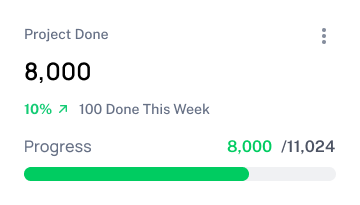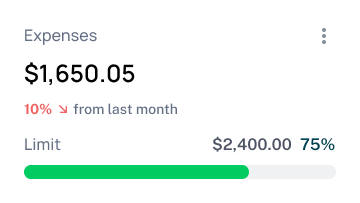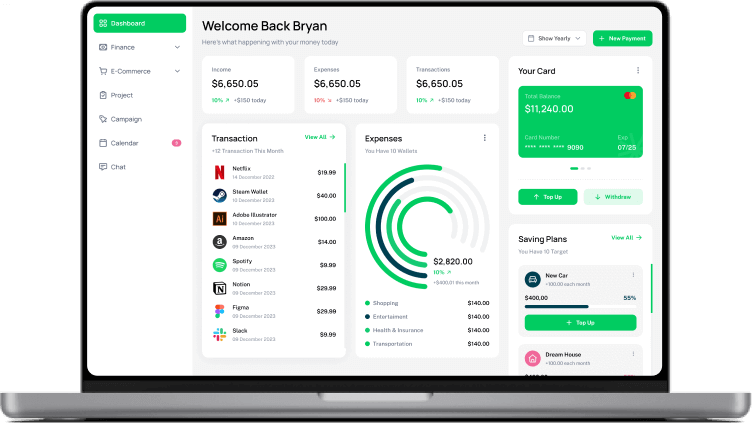Commission Tracking Made Simple!
Our Commission tracking software allows you to streamline your commission management and deal tracking processes for enhanced sales team performance and results.
- Free 15-Day Trial
- No Set Up Fee's
- Cancel Anytime

Monitor and Track Commissions
Our commission tracking software has been carefully crafted to oversee sales incentives. It offers the flexibility to create customized commission structures that align with sales strategies and team goals. With this system, you can accurately record every transaction. Calculate commissions based on the parameters set by your business. The management software tracks sales and commissions over time and provides detailed analytics that give a clear view of individual and team performance. By combining customization with tracking, our solution ensures transparency and efficiency in recognizing and rewarding your sales team's accomplishments.
Goal Setting
Personalized goal-setting and tracking to monitor and enhance performance in real-time.
Payment Calculations
Designed to accurately calculate and distribute earnings and meet personal targets.
Customer service
Maximize team engagement through insights into customer interactions and sales outcomes.
Custom Commission Structures
Tailor your incentive & commission structures allowing for flexible and dynamic commission plans that align perfectly with your business strategy.
Deal Management
Streamline your sales pipeline with our Deal Tracking feature, offering oversight and actionable insights for every sales opportunity.
Deal Management
It Has Never Been Easier To Manage Your Sales
Managing your sales has never been easier thanks, to our platform that simplifies every aspect of the sales process. Our commission tracking software offers a user interface that allows you to track deals and oversee your entire sales pipeline.
- Streamline every aspect of your sales process.
- Create deal flows to track success rates.
- Improve customer retention

Sales Tracking
Close More Sales,
& Improve Business
Our software features customizable commission structures and real-time analytics, allowing you to create targeted incentive strategies based on individual performance. This enhances sales team productivity while ensuring fair and transparent compensation management, ultimately boosting employee morale.
- Enhance productivity and morale with custom commission flows
- Create tasks for your sales team to close on deals
- Improve client satisfaction
Sales Force
Efficient and Simple
Team Management
With our management software, you can grow your business and manage large staff effectively, knowing that your sales management is efficient, effective, and effortlessly under control.
- Focus on business growth with efficient, transparent, and effective sales management.
- Improve team management and allocation.
- Increase productivity.

Customer Success Stories
Transform your business like others have with Flow Commission. Discover inspiring success stories of growth and innovation that could be yours next.
I’d like to express my gratitude for the outstanding service from Flow Commission! Their expertise and dedication truly set them apart, ensuring a seamless and effective experience.
Johnathan Frost
Founder & CEO

With steadfast support at every stage, Flow Commission provided us with impactful strategies that improved our business operations. Every aspect of their service was clear, well-structured, and designed for success.
Jennifer Sanders
Account Executive

The level of professionalism and attention to detail at Flow Commission is unmatched. Their team is highly skilled, ensuring every follow-up and ticket is handled with precision and care.
Evan Buchanon
Sales Manager

Stay Up To Date With Our Blog
Explore the latest trends, tips, and insights in our world. Get the knowledge to empower your business growth and increase productivity.
How to Build and Evaluate Sales Compensation Plans That Perform
Approach for Creating and Assessing Sales Compensation Plans The foundation of an accomplished sales team originates from offering a specific compensation system that excites team members. Generally speaking sales compensation involves more than pay levels since it serves as a vital business approach that shapes employee motivation and business results.

Why Insurance Agencies Need Automated Commission Tools
Automating Commission Tracking for Insurance Brokers Due to its manual nature, insurance brokers and agencies face commission management as their most tedious and problematic business process. Countless carriers, product lines, tiered commission schedules, bonuses, and overrides create chaos in manual tracking systems, causing errors, delayed payments, and unhappy agents. To
How Commission Tracking Helps Manufacturers and Wholesalers Improve Sales
Why Manufacturers, Wholesalers, and Product Sellers Should Leverage Commissions The fast-paced consumer product market drives businesses to discover better sales team motivation techniques and distribution growth strategies which maximize revenue generation. The implementation of commission-based compensation remains a dependable method which delivers value across all industries. Manufacturers alongside wholesalers and
FAQ
What is Flow Commission?
Flow Commission effortlessly tackles sales commission tracking by blending advanced software with automated analytics and smooth CRM connections. Flow Commission turbocharges sales and management teams with up-to-the-minute insights, automates the grunt work of number-crunching, and syncs effortlessly with existing CRM systems.
How does Flow Commission benefit sales teams and management?
Flow Commission not only ramps up the clarity and precision in tracking commissions, but it also kicks sales productivity into high gear, boosts team spirit, arms leaders with key insights for smarter choices, streamlines sales tasks, molds to your business’s unique contours, fuels teamwork like never before and scales right alongside your growing enterprise.
What are the key features of Flow Commission?
Flow Commission’s standout traits lie in its automated commission calculations, real-time insights, customizable plans, smooth CRM and sales tool integration, an intuitive design, plus the convenience of cloud access and mobile support.
- Automated calculations for commission
- Real-time analytics and reporting
- Custom commission plans and flows
- Seamless integration with CRM and sales tools
- User-friendly interface
- Cloud-based accessibility and mobile support
Can Flow Commission be customized to fit specific business needs?
Yes, Flow Commission allows businesses to design custom commission plans and flows that align with specific sales strategies and objectives. Flow Commission flexibly molds to various incentive structures, letting sales teams customize strategies that align perfectly with their specific business objectives.
Is Flow Commission suitable for businesses of all sizes?
For sure, businesses big or small can up their sales game with Flow Commission’s flexible system.
What industries benefit from using Flow Commission?
Flow Commission’s adaptability shines across numerous fields, such as real estate and tech sales, boosting their efficiency in managing transactions.
Flow Commission boosts sales productivity in a few key ways. It lets sales teams track their progress and pay in real-time. This motivates them to meet or pass their goals. Custom commission plans also give them an extra push. So Flow Commission helps fire up sales teams to sell more.
Sales reps, armed with up-to-the-minute data on their earnings, can see just how close they are to nailing their targets—fueling a competitive edge that propels them to outdo expectations. Customized commission plans further incentivize sales teams.
Can Flow Commission handle different commission structures?
Yes, Flow Commission is able to fit a range of commission setups, tailoring its approach to what each company needs, such as split commission, tiered commission and shared commission.
What type of analytics and reporting does Flow Commission provide?
With Flow Commission, you get a sharp look at your team’s sales achievements and pinpoint where those earnings are really stemming from.
Is Flow Commission accessible on mobile devices?
You can tap into Flow Commission on the go—it’s all cloud-based, so you’re good to manage your commissions anytime, anyplace with just a few swipes on your smartphone.
More Details
Commission Tracking & Deal Management Software
In today’s fast-paced sales environment, effectively managing sales commissions is not only necessary but also provides a strategic advantage. This is where Flow Commission comes into play, a state-of-the-art commission tracking software. By revolutionizing approaches, Flow Commission offers a user-friendly solution to the complex task of tracking sales incentives and commissions. As businesses transition from error-prone methods to sophisticated systems, our software emerges as a leader in simplifying and streamlining commission management. Flow Commission is designed to meet the evolving needs of sales teams by providing real-time analytics, automated calculations, and seamless integration with CRM and other business tools. The software introduces a level of transparency and accuracy to commission management, ensuring that sales teams are motivated and fairly rewarded for their work. Additionally, it automates the calculation and scheduling of commission payments, streamlining the distribution process and ensuring timely payouts. Unique features such as commission plans and flows offer flexibility, allowing businesses to align their incentive structures with specific sales strategies and objectives. In an era where data-driven decision-making is crucial, Flow Commission’s real-time analytics and comprehensive reporting capabilities empower sales managers and teams with actionable insights. This not only enhances productivity but also improves operational efficiency in the realm of sales. By automating the process to calculate commissions, Flow Commission helps sales teams save time and minimize the risk of mistakes. It is a tool for businesses of any size, as its adaptable commission tracking system is designed to meet diverse needs and enhance sales management efficiency.
Introduction
In today’s fast-paced sales environment, effectively managing sales commissions is not just necessary but also provides a strategic advantage. This is where Flow Commission comes into play, a state-of-the-art commission tracking software. By revolutionizing traditional approaches, Flow Commission offers a user-friendly solution to the complex task of tracking sales incentives and commissions. As businesses transition from error-prone methods to sophisticated systems, our software emerges as a leader in simplifying and streamlining commission management. Flow Commission is designed to meet the evolving needs of sales teams by providing real-time analytics, automated calculations, and seamless integration with CRM and other business tools. The software introduces a level of transparency and accuracy to commission management, ensuring that sales teams are motivated and fairly rewarded for their work. Unique features such as commission plans and flows offer flexibility, allowing businesses to align their incentive structures with specific sales strategies and objectives. In an era where data-driven decision-making is crucial, Flow Commission’s real-time analytics and comprehensive reporting capabilities empower sales managers and teams with actionable insights. This not only enhances productivity but also improves operational efficiency in the realm of sales. By streamlining the calculation of commissions, Flow Commission helps sales teams save time and minimize the risk of mistakes. It is a tool for businesses of any size, as its adaptable commission tracking system is designed to meet diverse needs and enhance sales management efficiency.
What is Commission Tracking Software?
Commission tracking software is a digital tool designed to help businesses manage and automate the calculation and distribution of sales commissions. It is an essential component of sales compensation management, enabling organizations to streamline their commission processes, reduce errors, and increase transparency. By leveraging commission tracking software, sales teams can focus on driving revenue growth, while finance and operations teams can ensure accurate and timely commission payouts. This software not only simplifies the complex task of calculating commissions but also provides real-time insights into sales performance, making it easier for sales leaders to make informed decisions. With just a few clicks, businesses can set up and manage their commission plans, ensuring that sales representatives are motivated and fairly compensated for their efforts.
Key Features of Flow Commission Sales Commission Software
Flow Commission revolutionizes the management of sales commissions by offering advanced commission tracking software. It is a game changing solution, for companies aiming to simplify their sales compensation processes. With a range of features it enhances efficiency, accuracy and transparency, in commission management. In this article we will delve into the attributes that set Flow Commission apart from sales incentive management systems in todays fiercely competitive market.
Automated Calculations
Flow Commission’s heart lies in its ability to automate complex commission calculations. This feature eliminates the tedious and error-prone task of manual calculations, ensuring sales representatives are compensated accurately and promptly. By leveraging advanced algorithms, the software can handle various commission structures and rates, adapting to the unique needs of each business.
Real-Time Analytics and Reporting
Flow Commission provides an analytics solution in time giving sales teams and managers immediate access, to valuable insights on sales performance and earnings. This functionality empowers businesses by equipping them with the data to make informed decisions monitor progress, towards sales goals and identify areas that can be improved upon. The comprehensive reporting tools enable users to generate reports that clearly illustrate sales trends and commission patterns.
Custom Commission Plans and Flows
Understanding that one size does not fit all in sales commission management, Flow Commission provides extensive customization options. Businesses can design custom commission plans and flows that align with their specific sales strategies and objectives. Whether it’s tiered commission structures, bonuses, or SPIFs (Sales Performance Incentive Funds), Flow Commission can accommodate many incentive models, providing the flexibility businesses need to motivate their sales force effectively.
Seamless Integration with CRM and Sales Tools
In today’s interconnected business world, the integration of customer relationship management (CRM) systems with sales commission software is crucial. Flow Commission seamlessly integrates with CRM systems and sales tools, streamlining the sales process. This integration ensures that all relevant data is automatically synchronized, providing a view of the sales pipeline and commission calculations. By connecting with these tools, Flow Commission enhances the efficiency and effectiveness of sales operations.
User-Friendly Interface
Recognizing the importance of usability Flow Commission offers a user interface that makes commission tracking accessible to all members of the sales team regardless of their expertise. The intuitive design ensures that users can easily navigate through the software view their commission earnings and understand their performance metrics. This user friendly approach saves time. Improves the experience for users making Flow Commission a preferred choice for businesses of any size.
Cloud-Based Accessibility and Mobile Support
In an era where mobility and flexibility’re crucial Flow Commission provides cloud based accessibility that allows users to manage and track commissions from anywhere, at any time. The platforms mobile support ensures that sales representatives can stay updated on their commissions and sales performance while on the move giving them the flexibility they need in a paced sales environment.In summary Flow Commission offers a package, for companies looking to update their commission tracking systems. With its combination of automation up to date data analysis, customization options, smooth integrations, easy to use interface and mobile access it stands out as one of the choices, in the sales commission software market. By implementing Flow Commission businesses can guarantee that their sales teams stay motivated receive compensation and have the resources to achieve success.
Benefits for Sales Teams and Management with Flow Commission Sales Compensation Management
Having sales management and a motivated sales team is vital, in todays competitive business environment. Flow Commission, a commission tracking software offers advantages that can transform sales teams and their performance.
Increased Transparency and Accuracy
One of the advantages of using Flow Commission is its ability to improve transparency and accuracy in managing commissions. The softwares automated calculation feature ensures recording of every sales transaction and accurate calculation of commissions without any errors. This level of precision builds trust among the sales team as they know they are being fairly compensated for their work. As a result there are disputes or concerns regarding commissions, for the management leading to operations.
Boost in Sales Representatives’ Productivity and Morale
Flow Commission significantly contributes to increased sales productivity by providing real time analytics and reporting. Sales representatives can monitor their performance and commissions in time which motivates them to meet or exceed their targets. Furthermore the software allows customization of commission plans and flows enabling sales teams to observe how their efforts impact their earnings.
Strategic Sales Insights for Better Decision Making
Flow Commission provides analytics and data driven insights that empower sales managers and leaders to make informed strategic decisions. By accessing sales performance data management can identify trends, fine tune sales strategies. Allocate resources more effectively. This level of insight is crucial, for staying in a market. Additionally, the software helps in forecasting future commission expenses by utilizing historical sales data and commission payout metrics, aiding in effective budgeting and resource allocation for sales teams.
Efficiency in Sales Operations
Flow Commission seamlessly integrates with CRM systems and other sales tools streamlining the sales process from generation to commission payout. This enhanced efficiency saves time. Reduces burdens on sales teams allowing them to focus more on selling rather than paperwork. For management automating commission calculations and reporting frees up time for planning of operational concerns.
Customization to Fit Unique Business Needs
Every business has its commission structures, which is why Flow Commission offers customizable sales compensation plans and flows. Whether it’s a percentage-based plan or an intricate tiered structure, Flow Commission can adapt accordingly, making it an ideal solution for tracking deals for businesses of all sizes and industries.
Enhanced Team Collaboration and Alignment
Flow Commission enhances collaboration throughout the sales process. The softwares reporting and tracking features ensure that everyone on the team from sales representatives to managers is aligned with the companys goals and compensation plans. This alignment fosters a efficient sales team ultimately driving overall business success.
Scalability and Future-Proofing
With Flow Commission your business can scale effortlessly to accommodate changing needs. It adjusts to sales strategies expanding teams and evolving market demands. This scalability guarantees that as your business grows your commission tracking and management system grows alongside it ensuring long term viability for your sales operations. Additionally, our platform supports incentive compensation, optimizing commission plans to improve sales performance and streamline workflows.
Sales Compensation Management
Sales compensation management is a critical aspect of revenue operations, as it directly impacts sales team performance and motivation. A well-designed compensation structure should align with business goals, drive desired behaviors, and provide a clear understanding of how sales commissions are calculated and paid. Effective sales compensation management involves setting clear goals, defining commission rates, and establishing a transparent process for calculating and distributing commissions. By doing so, businesses can ensure that their sales teams are motivated to achieve their targets and contribute to the overall success of the organization.
Understanding Compensation Structures
Understanding compensation structures is fundamental to effective sales compensation management. These structures should be designed to align with the company’s strategic objectives and drive the desired sales behaviors. Key components include setting clear and achievable sales goals, defining commission rates that reflect the value of different sales activities, and ensuring a transparent process for calculating and distributing commissions. By providing a clear understanding of how sales commissions are calculated and paid, businesses can build trust and motivation within their sales teams. This transparency not only reduces disputes but also helps sales representatives understand how their efforts translate into earnings, thereby driving better performance and job satisfaction.
Aligning Compensation with Business Goals
Aligning compensation with business goals is crucial to driving sales team performance and revenue growth. By tying commission payouts to specific business objectives, organizations can incentivize sales reps to focus on high-value activities and drive desired outcomes. This approach also enables sales leaders to measure the effectiveness of their compensation plans and make data-driven decisions to optimize performance. By leveraging sales commission software, organizations can automate the commission calculation process, reduce errors, and provide real-time visibility into sales performance and compensation data. This alignment ensures that sales representatives are not only motivated to achieve their targets but also contribute to the broader strategic goals of the organization.
Case Studies / Success Stories
Flow Commission has revolutionized businesses sales incentive programs through its innovative commission tracking software. Our case studies and success stories demonstrate the impact our software has had across industries showcasing its versatility and effectiveness.One inspiring success story involves a sized retail company that was grappling with an outdated commission system causing frequent errors and dissatisfaction, within their sales team. After implementing Flow Commission they experienced a turnaround. The automated calculation feature eradicated errors while significantly reducing the time previously spent on processing.The sales team experienced an increase, in motivation and performance due to the insights provided by real time analytics. This resulted in a 30% rise in sales during the quarter after implementing this system.Another noteworthy example involves a real estate agency facing challenges with commission structures. By utilizing Flow Commissions customized commission plans and flows they were able to tailor their incentive programs to suit their business model. This increased flexibility led to an more transparent compensation system resulting in higher agent satisfaction and loyalty. The agency observed an improvement in agent retention rates and a 25% growth, in revenue.These success stories highlight the capabilities of Flow Commission when it comes to managing sales commissions across industries. Flow Commission proves essential for businesses aiming to optimize their sales performance streamline operations ensure accuracy and boost morale within their sales teams.
Ease of Commission Tracking and Commission Payouts with Flow Commission
When it comes to keeping track of commissions, the simplicity and user friendliness of the software are just as important, as its features. Flow Commission, a commission tracking software stands out in the market for its to use interface. It ensures that both sales teams and management have a hassle experience when it comes to commission tracking.One key factor that contributes to Flow Commissions user friendliness is its user interface. The software has been designed with the users in mind providing a dashboard that even those without expertise can easily navigate. This thoughtful design ensures that all users regardless of their level of tech savviness can conveniently access and understand their commission information. This promotes a sense of independence and empowerment among sales teams.Moreover automating commission calculations simplifies the process. In the past calculating commissions could be time consuming and prone to errors. However with Flow Commission this process has been streamlined. Sales teams can rely on the accuracy of their commission calculations while management saves time that can be better utilized for planning and sales coaching.Another notable feature that enhances Flow Commissions ease of use is its real time tracking capability. Sales representatives have access to view their earnings and track their progress, towards targets in time. This fosters a sales environment.Flow Commission sets itself apart in the market by prioritizing simplicity and usability alongside its range of features when it comes to tracking commissions.The sales team finds motivation, in the ability to have real time visibility, which allows them to receive feedback on their efforts. Moreover this visibility feature assists managers in identifying and addressing any performance issues that may arise. Flow Commissions seamless integration with business tools, such as CRM systems further enhances convenience. This integration capability ensures data flow between systems reducing the need for data entry and minimizing the risk of errors.To summarize Flow Commission combines an interface, automated processes, real time tracking and smooth integration to make commission tracking simple, efficient and accurate. This user friendly approach is a reason why many businesses choose Flow Commission as their solution, for commission management.
Custom Commission Flows and Rates in Flow Commission
When it comes to sales commission software, the real game changer is the ability to customize commission structures. Flow Commission truly excels in this area by offering flexibility through its Custom Commission Flows and Rates feature. This feature is what sets Flow Commission apart as it caters to the needs of businesses, across industries.With Flow Commissions Custom Commission Flows businesses have the power to design commission structures that perfectly align with their sales strategies and goals. Whether its setting up commission rates incorporating performance thresholds or defining rates for different products or services Flow Commission provides the necessary flexibility for precise customization. This level of personalization ensures that businesses can create incentive plans that genuinely motivate their sales teams while also aligning with objectives.In addition one standout aspect of Flow Commission is its ability to set up custom commission rates. Sales teams often encounter product lines or services that require varying commission rates. With Flow Commissions system configuring these rates becomes effortless guaranteeing accurate compensation, for each sale based on predefined criteria.This customization capability empowers sales managers to implement motivating commission plans while maintaining transparency and fairness throughout the sales compensation process.Sales representatives have an understanding of how their commissionsre calculated and what they need to do to maximize their earnings. This knowledge. Focuses the salesforce resulting in performance.Flow Commissions user friendly interface complements these customized features. The softwares intuitive design allows users to easily set up and adjust commission structures without needing expertise or support.In essence the Custom Commission Flows and Rates feature of Flow Commission showcases its adaptability and user centered design. It equips businesses, with the tools to create personalized commission plans that effectively incentivize sales teams to excel aligning their efforts, with the organizations objectives.
Additional Features of Flow Commission
Flow Commission is a regarded commission tracking software, in the market due to its core features and wide range of additional functionalities. These features are specifically designed to enhance user experience, improve efficiency, and ensure a level of security, making Flow Commission an all-in-one solution for managing sales commissions. One notable additional feature is Mobile Accessibility. In today’s world, it is crucial to have access to commission data while on the move. Flow Commission’s mobile-friendly design ensures that sales representatives and managers can easily track commissions, view reports, and receive real-time updates from anywhere and at any time. This level of accessibility boosts productivity and allows for monitoring of sales performance.
Cloud-based technology is another standout feature offered by Flow Commission. By hosting data in the cloud, this software provides access to commission information in real time. This enables effortless data retrieval and backup processes while ensuring that system updates and new features can be seamlessly implemented to keep pace with advancements.
With regards to security and data protection, Flow Commission prioritizes these aspects as concerns. Recognizing the sensitivity of commission-related data, this software incorporates security protocols to safeguard user information. This includes using encryption, implementing login processes, and conducting security audits to ensure that all the information within the platform is protected against unauthorized access.
Custom Reporting Tools in Flow Commission enable businesses to generate reports based on data points. These tools provide insights into sales trends, commission breakdowns, and team performance, helping management make informed decisions. Moreover, Integration Capabilities go beyond CRM systems. Flow Commission can seamlessly integrate with payroll systems, accounting software, and other essential business tools, creating an ecosystem for managing all aspects of sales and commissions. This integration capability ensures data flow between systems, reducing the need for data entry and minimizing the risk of errors. Additionally, integrating sales data automates commission payouts, provides real-time metrics, and creates historical reports that help in auditing and compliance processes.
Industry-Specific Applications Flow Commission’s advanced commission tracking software is not just a one-size-fits-all solution but is specifically designed to cater to a wide range of industry-specific applications. This versatility makes it an ideal choice for various sectors with unique sales and commission structures.
Real Estate Industry
Agents and brokers play a role, in the real estate sector, where they handle intricate and valuable transactions. Flow Commission is a solution designed to manage complex commission structures in this industry. It offers tailored features for handling split commissions bonuses tied to sales targets and referrals which’re particularly advantageous in this line of work.
Retail Sector
The retail sector can greatly benefit from Flow Commissions capabilities in managing commissions for sales teams. Whether its stores or large chains the software easily adapts to the paced and high volume nature of retail sales. It ensures tracking of sales incentives linked to team performance.
Insurance
For the tech industry in software sales where recurring revenue commissions and one time sales bonuses are models Flow Commission offers essential management capabilities. This feature proves crucial as it caters to subscription based as traditional approaches to selling software.
Technology and Software Sales
Flow Commission offers the ability to manage recurring revenue commissions and one-time sales bonuses for the tech industry, especially in software sales. This feature is crucial in an industry where sales models include subscription-based and traditional sales approaches.
Telecommunications
In telecommunications, where contract-based sales and renewals are prevalent among sales organizations, Flow Commission provides support for managing these processes effectively. Flow Commission’s tracking and reporting capabilities are invaluable for managing commissions associated with both new contracts and renewals. This makes it a versatile tool that meets the demands of this changing industry.

